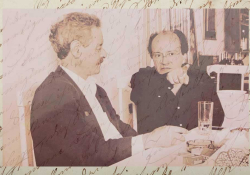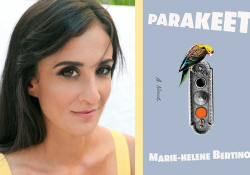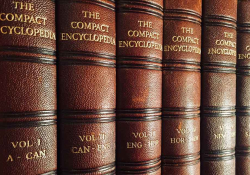Resettling in the United States: A Fiction’s Telling

Tracing the path of refugee resettlement in the United States through contemporary fiction and memoir not only informs readers of the refugee process but reveals the connections that settled Americans may have with new, resettling neighbors.
At present, the globe is experiencing the highest number of refugees on record. The volume and gravity of the situation magnetizes attention to the plight of refugees, forcing countries, communities, and individuals to assess if they can, should, or want to help. Literature about the refugee experience is as important now as ever for its provision of the time and space that allows intimacy between refugees on the page and readers who are otherwise uninvolved with the refugee community. Chinua Achebe said that one of literature’s greatest achievements is its ability to provide a “second handle on reality” that allows readers to approach, through story, the “threats to integrity that may assail the psyche in real life.” The following works of fiction and memoir not only trace the process of refugee resettlement to the United States but, more importantly, allow readers to discover what they have in common with people who have endured so many threats to their integrity.
1. “Waiting”: Refugee Camps
After war, persecution, and trauma, many of the world’s 21.3 million refugees will spend time in a refugee camp. Camps intend to provide temporary shelter and livelihood, though they often force people into situations of abject dependence, absent of opportunity to pursue sustainable, productive lives. E. C. Osondu explores this camp experience in the story “Waiting” (2010), in which a child narrator leads the reader through several hours in an anonymous refugee camp. This child has been taken without family or friends to the camp and renamed Orlando Zaki when he arrives there, both for the town where he was found, Zaki, and for what was written on the T-shirt he received from the Red Cross. Other children in the camp are also named by what is on their donated shirts, so that Zaki lives with Sexy, Paris, Lousy, and Acapulco. The reader sits with Zaki through a typical dusty day, the tedium of which Osondu emphasizes linguistically: in one paragraph alone, Osondu uses the word “wait” nine times, and throughout the piece, he separates verbs with “and” instead of commas (“we fight and struggle and bite and kick”), forcing the reader to repeat these actions with Zaki. The story ends with Zaki wanting to distance himself from the others, leaving a sudden gap between himself and the reader. This abrupt break reminds the reader that Zaki has nowhere to go. He will wander away for now but must come back to wait for lunch the next day, and the next, at the mercy of elements over which he has no control.
2. “The Infamous Tests”: Referral to Resettle in the United States
Zaki and the millions of people in refugee camps around the world face three possibilities: return home, integrate into the hosting country (which in many cases means remaining in the camp), or resettle in a third country. The U.S. Department of State posits that it is a small number of refugees, about 1 percent, who cannot return home without putting their lives at risk and must resettle elsewhere.This last situation subjects people to a bureaucratic and international process requiring layers of interviews, paperwork, and documentation, all of which can drag on for an average of eighteen to twenty-four months. Mawi Asgedom, an Ethiopian refugee who resettled in the United States as a child, states in his memoir Of Beetles & Angels: A Boy’s Remarkable Journey from a Refugee Camp to Harvard (2002) that this application process is wrapped in mystery for most refugees. Families qualify for resettlement by passing “the infamous tests,” which seem to be given passing or failing grades regardless of what answers are given.
The U.S. Department of State posits that it is a small number of refugees, about 1 percent, who cannot return home without putting their lives at risk and must resettle elsewhere.
Chimamanda Ngozie Adichie’s story “The American Embassy” (2010) suggests that the opaque process of referrals for third-country resettlement depends heavily on an applicant’s narrative; more specifically, Adichie reveals how those who are not able to tell their narratives are left behind. The protagonist waits in line for the American embassy in Lagos along with a hundred other people. Two days earlier, three men had come to attack her husband because of his political writing; her husband was not home, but the men killed their young son, and the protagonist jumped from the balcony window to escape. Her husband flees Nigeria with plans to fly to the U.S. on a previous tourist visa, seek asylum, and find his wife there.
Once inside the embassy—no small feat, considering the length of the line and the embassy’s reputation for shutting down suddenly without explanation—the protagonist is interviewed by a woman behind glass. The interviewer asks for more details about what happened. Our protagonist knows this is her chance to be granted asylum, but she is stopped by the feeling that she is “hawking” her son “for a visa to safety.” The protagonist ultimately leaves the embassy, abandoning the reader without answers—will she return and tell her story? what will happen if she doesn’t?—but with a shared sense of violation. The process of telling officials what happened in exchange for access to safety is revealed as psychologically demanding of applicants and perhaps even inappropriate.
Edwidge Danticat’s memoir Brother I’m Dying (2007) suggests another obstacle to being heard: hasty, bureaucratic logistics. Danticat’s uncle relents after years of refusing to leave the increasingly dangerous Haiti and tries to join his family in New York. At the Florida airport, he is detained without rights to notify his family, sent to a detention center where his medical condition is ignored, and dies under horrific conditions. Danticat later learns that although her uncle had the proper documentation to enter the United States, he more or less checked the wrong box on one of many forms.
3. “We, I, can’t, won’t, will never be able to go back”: Resettling in the United States
Refugees referred to the United States may resettle in Colorado, Maine, or Southern California; these new homes are less a clean break from the trauma of the past and more a jagged, imperfect entry into a foreign society. Invited refugees are provided transportation from the refugee camp to the United States on loan, which they must begin repaying within six months of arrival. For three months, the U.S. Department of State provides a small amount of money to defray the costs of settling in a new country, expecting the new resident to begin employment within six months of arrival. Employment within six months is an ambitious goal even for native English speakers with an education, a résumé, and free from the effects of recent trauma. Resettling refugees are welcomed to the U.S. under extraordinary pressure to begin a new life.
Dinaw Mengestu’s novel How to Read the Air (2010) takes readers behind the desks of resettlement agencies in the United States. The protagonist, Jonas, works at the Center for Refugees in New York, where he reads refugees’ stories to help him apply for their assistance funds. While Adichie’s story suggests that a refugee’s future depends on his or her narrative being heard, Mengestu’s narrator wonders if this narrative must not only be told but also told well. The audiences listening to these stories may have heard similar tales dozens of times over, so that an individual’s story becomes, ironically, predictable in its horror. Even Jonas, whose parents are refugees and whose career focuses on resettlement, blurs together the stories of individual applicants. He laments that most of the testaments he reads end with “We, I, can’t, won’t, will never be able to go back.” He admits to feeling “tired suddenly” from reading the stories, and he suspects that “this was how much of the country felt as well. We were straining to break our hearts.” He becomes as detached from the stories as an average citizen is from a list of statistics on a UNHCR webpage.
Ironically, in addition to facing apathy from new neighbors, resettling refugees may also be burdened by conspicuousness. Valentino Achak Deng, a nonfictive refugee from the second Sudanese civil war and the protagonist in Dave Egger’s semibiographical novel What Is the What (2006), explains that “We Sudanese . . . look like no one else on Earth.” Deng and his Sudanese roommate spend most of their first weeks in the United States hidden in their apartment, worried that the smallest, unintentional infraction will get them sent back to the war.
It is perhaps a universal experience to encounter biases, prejudice, and assumptions; it is less common to be feared by strangers as a murderer before speaking a word.
Teju Cole’s Open City (2011) investigates the effects that assumptions, ignorance, and rumor can have on a nonrefugee’s perception of refugees. Julius, a Nigerian German immigrant in the United States for medical school, meets with Saidu, a refugee from Liberia now stuck at a detention center. Saidu shares that his school was burned, that he was captured by the rebels, and that he escaped first to Guinea and then to the United States. Julius wonders if it “wasn’t more likely that he had been a soldier.” Later in the novel, Julius experiences what he calls “mental constriction” upon realizing that a club is full of Rwandans: “It was as though the space had suddenly become heavy with all the stories these people were carrying.” More detrimentally, he grows suspicious that those around him “could have killed and killed and only later learned how to look innocent.” It is perhaps a universal experience to encounter biases, prejudice, and assumptions; it is less common to be feared by strangers as a murderer before speaking a word.
For some resettling refugees, the weighty external challenges mentioned above work in tandem with complicated internal adjustments. The kind of grief and post-traumatic stress that silences Adichie’s protagonist in Lagos might remain with victims for the rest of their lives and could manifest unexpectedly. The graphic novel 99 Days, by Matteo Casali (2011), for example, follows a man who survived the genocide in Rwanda and has resettled in LA, working as a cop. Though the protagonist has never been free of the ghosts of his murdered friends and family, or of the murdering he was forced to commit, he has found a way to function in a new life—until he works on a gang case involving murders with a machete. This weapon, so often used in the Rwandan genocide, loosens the violence embedded in the protagonist’s past, and his anger accelerates until he actively seeks revenge on the criminal. The novel ends violently, depicting images from Rwanda: bones, skulls, genocide. The distress from the cop’s past unsettles his resettled life in LA.
Finally, refugees resettling in the United States are burdened with the same challenges as any person building a new life: finding a place in society. Dinaw Mengestu’s debut novel, The Beautiful Things That Heaven Bears (2008), follows Sepha Stephanos, a refugee from Ethiopia who has lived in Washington, D.C., for seventeen years. Sepha feels disconnected not only from Americans but also from other Ethiopian refugees. Sepha’s one uncle lives in an apartment building hosting a robust Ethiopian community, and Sepha avoids this community because it is “as close to living back home as one can get.” For Sepha, Ethiopia can’t be extracted and inserted into D.C., a notion that cuts him off from Ethiopians who think otherwise. Life in Ethiopia has disappeared for Sepha, and now any Ethiopia in his life is equally hard to hold on to.
4. Conclusion
The authors cited above create a body of literature that does more than trace the process experienced by thousands of people every year. Spending time with Zaki, Valentino, Sepha, and others provides the time and space for readers to connect with individuals experiencing refugee camps, referral, and resettlement. Civil war, violence, trauma, and injustice are topics that we may wish we did not have to read about and topics that authors perhaps wish they did not feel compelled to write about; however, just as the recent and alarming volume of global refugees has pushed Europe and other regions into action, fiction about this topic pushes readers to turn toward global crisis rather than away. Creating and reading literature about topics that appear foreign or unpleasant helps us to better understand that we cannot control what happens on the other side of the globe, or who will be our new neighbor, or how they will become our neighbors. What we can do, and what literature assists with, in its unique capacity to create Achebe’s “second handle on reality,” is recognize that the people experiencing these events are possibilities of ourselves, born elsewhere.
Denver, Colorado










